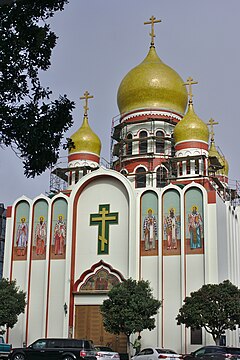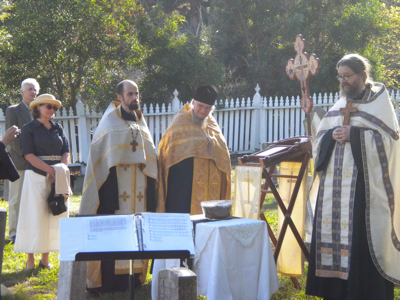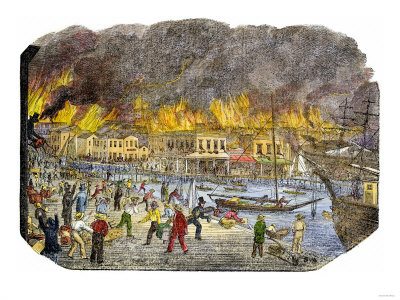Closing Russian mission in San Francisco slaps a rich cultural history
By The Wayne Madsen Report
The 48-hour notice given to the Russian government before FBI and CIA agents rummaged through the consulate-general forced consular staff to initiate an emergency destruction protocol. Consular officials had to burn sensitive blank visas, files containing personal data on U.S. and Russian nationals, and other sensitive material, including Russian coding documents, as San Francisco thermometers reached triple-digit temperatures. While Russian crews in San Francisco were hastily packing to meet the 48-hour notice, the staffs of Russian trade offices in New York and Washington were also busy emptying their buildings. However, in New York and Washington, Russian diplomats had the luxury of moving some of the more critical files and equipment to the Russian Mission to the United Nations and the Russian embassy. The San Francisco mission did not have that choice. Russian President Vladimir Putin called the U.S. move "boorish."
Even after the U.S. severed diplomatic relations with Nazi Germany subsequent to the 1941 Pearl Harbor attack, the U.S. never entered the grounds of the German embassy on Massachusetts Avenue. Moreover, the German staff was given enough time to burn classified coding material before they turned themselves in to American authorities for internment at White Sulphur Springs in West Virginia. The Swiss government, not the FBI, took possession of the German embassy as the protecting power for Germany in the United States. The literal storming of the Russian missions by FBI and CIA personnel during a period of full diplomatic relations with Moscow is without precedence in modern U.S. diplomatic history. The actions are more of those of a Third World banana republic than a functioning democracy.
The last time a country gave a 48-hour notice to a diplomatic mission to pack up and leave was in January 2016, when Saudi Arabia gave Iran two days to evacuate its embassy in Riyadh. The move followed the Saudi severance of diplomatic ties with Iran.
In 1961, when the U.S. shut down its embassy in Havana following the severance of diplomatic relations between Cuba and the United States, U.S. ambassador Philip W. Bonsal was faced with the problem of having to destroy or transfer some 50,000 visa applications that were on file from Cubans wanting to come to the U.S. Had these files fallen into Cuban government hands, the repercussions for the visa applicants may have been swift and sever. Yet, the Trump administration showed no regard for the thousands of visa applications and U.S. and other passports that were in the hands of the Russian Consulate-General when it issued its Third World-style 48-hour closure notice.
In 1973, the U.S. embassy in Kampala, Uganda was closed within a 48-hour window as a result of threats to the embassy staff from the cannibalistic Ugandan dictator General Idi Amin. The evacuation of the embassy came after Amin sent President Richard Nixon a message that wished him "a speedy recovery from Watergate." The Deputy Chief of Mission had to contend with many issues in the two-day window provided for evacuation: the breaking of leases; transferring U.S. diplomatic property to the protecting power, West Germany; and providing local employees with normal and severance pay. In the case of the Russian Consulate-General in San Francisco, there is no protecting power to assume control of the property since diplomatic relations with Russia have not been severed. The missions is San Francisco, New York, and Washington have been placed under U.S. State Department custodianship. In any event, Donald Trump's 48-hour notice is more in keeping with the diplomatic protocol recognized by Idi Amin than any rational world leader.
The Russian Consulate-General, with the exception of a few intervening years, was the oldest foreign consulate in San Francisco. The consular office, located at 2790 Green Street in the Cow Hollow neighborhood, has served as a cultural center for San Francisco’s Russian-American and Russian community in San Francisco. The decision by Washington to close the Russian consular office in San Francisco was as much a cultural slap for an American ethnic group as would have been the expulsion of the Irish consulate in Boston, the Israeli Consulate-General in New York, the Mexican Consulate-General in Los Angeles, or the French Consulate-General in New Orleans.
The Russian Consulate-General, located at 2790 Green Street in the Cow Hollow neighborhood -- the fourth address for the consulate -- served as a cultural center for San Francisco’s large Russian-American and Russian community. The decision by Washington to close the Russian consular office in San Francisco was as much a cultural slap for an American ethnic group as would have been the expulsion of the Irish consulate in Boston, the Israeli Consulate-General in New York, the Mexican Consulate-General in Los Angeles, or the French Consulate-General in New Orleans.

Trump's diplomatic moves are more like those of Ugandan dictator Idi Amin than any rational democratic leader
The history of the Russian diplomatic presence in San Francisco goes back to 1852. The first Russian diplomatic envoy in the Bay Area, Vice Consul Peter Kostromitinov, also served as the chief administrator for Russian settlers in Alta California, who were the original inhabitants of the first Russian-American Company colony at Fort Ross, established in 1812. Fort Ross was located on what is now Bodega Bay, previously known to the Russians as the Gulf of Rumyantsev. Fort Ross -- Ross being the shortened word for "Rossiya" -- was the hub for Russian settlements along the northern California and Oregon coasts and which extended inland along the banks of the Russian River to towns like Sebastopol. Fort Ross was also linked to the Russian community in the Russian Hill district of San Francisco.

The Russian-Orthodox Holy Virgin Cathedral in San Francisco, founded in 1961 by St. John of Shanghai and San Francisco (Mikhail Maximovitch), who is buried within the cathedral. The cathedral serves as the center of San Francisco's Russian community and is surrounded by Russian restaurants and shops [left]. Russian architecture on Russian Hill [right].
There is some question about the legality of the sale of the Russian-American colony to the agent for a Mexican citizen originally from Switzerland named John Sutter, of California Gold Rush infamy. Sutter's agent, a pro-slavery former Comptroller of the U.S. Treasury named William Montgomery Steuart, may have swindled the Russians in the sale by the Russians of their California land holdings sometime between 1841 and 1849. There is no record of the agreed to price of between $20,000 and $30,000 in gold and U.S. currency being paid to the Russian government by either Steuart or Sutter, both known to be notorious grifters of their time. Historians cannot agree on the actual year of the alleged sale and accounts claim it was in 1841, 1842, and 1849. Lacking is any legitimate documentation proving the date of the sale or its overall legality. What is known is that in 1848 gold was discovered in California and Sutter presided over an onrush of schemers and ne'er-do-wells who flooded into the region, mostly from points east.
Under business law, the lack of a consideration in a contract, in this case money, would result in a null contract. However, under English civil law, which permits adverse possession of property by usurpers, invaders, or squatters, there is little legal recourse for the Russians today. However, in a purely legal world, without arcane feudalistic laws that permitted the ownership of humans as chattel and occupation of native American lands by white invaders, instead of the U.S. ordering Russian Consul-General Sergey Petrov from the Russian compound in San Francisco, the Russians could have ordered the U.S. government out of Russian-claimed lands from Point Arena to Tomales Bay and Sebastopol and Santa Rosa to Healdsburg and Forestville. Unlike the Americans, Spaniards, and Mexicans, the Russian-American Company agents who first set shore upon the Alta California coast and the banks of the Russian River negotiated the sale of lands from the local native American tribes. In fact, the Russians treated the local native peoples as equals and not as savages, as was the method of the Americans.
The original Russian consulate on California Street in San Francisco displays the typical Russian architecture of the era.
From 1863 to 1864, the Russian Consulate in San Francisco served as an important liaison between the Union forces and the Russian Far East Fleet. Tsar Alexander II, in response to a request from President Abraham Lincoln for Russian help in defending the two critical American ports of San Francisco and New York, dispatched his Far East and Baltic Fleets to San Francisco and New York, respectively. The Far East Fleet that arrived from Vladivostok consisted of the Finnish-built corvette Kalevala, three other corvettes, Bogatyr, Rynda and Novik, and two Finnish-built clippers, the sister-ships Abrek and Vsadnik.
With the defense of New York and San Francisco in the hands of the Russians, the U.S. Navy was free to attack Confederate ports, as well as Confederate merchant ships and raiders. One such raider, the CSS Shenandoah, transferred to the Confederacy by the British Navy, was planning to attack San Francisco. However, when Confederate spies in the city reported to the Shenandoah that the Russian fleet commander, Rear Admiral A. A. Popov, ordered his ships to fire on and sink the Shenandoahupon first sight, the Confederate ship decided to head for southern waters to prey on unarmed American whaling fleets.
Smoke from the emergency destruction of visa files and other sensitive documents billows from the chimney atop the Russian Consulate-General in San Francisco
In 1867, the deal whereby Russia sold its Alaska Territory to the United States was partly enabled by the ethnc Finnish consul for Russia in San Francisco, Gustave Niebaum. Finland was then an autonomous Grand Duchy of the Russian Empire. In 1879, Niebaum established the Inglenook Winery in Rutherford, California.
A certain element in the Bay Area has never liked the Russian diplomatic presence in the region. In 2011, when the Russian Consulate-General, along with the Russian Orthodox Church and the Mare Island Historic Park Foundation, attempted to restore the head stones of six Russian sailors who died in 1863 while fighting a raging fire in what is now the financial district of San Francisco, near the piers. The fire may have been started by Confederate saboteurs. The city of Vallejo tried to charge the Russian Consulate-General with "graveyard vandalism" for restoring the headstones without city approval. The Russians had originally been buried with full U.S. Navy honors in 1863. However, the Navy abandoned closed the cemetery in 1921 and successive commanders of the Mare Island naval base permitted the cemetery to decay. The Mare Island base was closed in 1995. It turns out that the Russian graves became pawns in a spat with Russia over its treatment of gays and, since the Bay Area has a vocal and, at times, extremely vindictive gay community, including a particularly noisy group called "Gays Without Borders," Russia's good intentions with regard to the graves did not go unpunished.
Annual Russian Orthodox ceremony at the Mare Island cemetery honoring the six Russian sailors who died fighting the 1863 San Francisco fire. The Russian Consul General oversaw the planning for the annual event but will no longer after the expulsion by the Trump administration of the entire consular staff.
An invitation by the San Francisco Fire Department for Russian President Vladimir Putin to attend the 150th anniversary of the Russian Navy's fire fighting assistance and to commemmorate the deaths of the Russian sailors was pulled as a result of political pressure from San Francisco's gay aristocracy. The original SFPD invitation read as follows:
"Dear President Putin,
The San Francisco Fire Department will officially take part in celebrating this event and welcomes participants from San Francisco and the sailors from Russia to join in the activities as they are the heirs and surviving legacy of the heroism of the past, We would be honored to have you visit San Francisco.”


Trump's diplomatic moves are more like those of Ugandan dictator Idi Amin than any rational democratic leader
The history of the Russian diplomatic presence in San Francisco goes back to 1852. The first Russian diplomatic envoy in the Bay Area, Vice Consul Peter Kostromitinov, also served as the chief administrator for Russian settlers in Alta California, who were the original inhabitants of the first Russian-American Company colony at Fort Ross, established in 1812. Fort Ross was located on what is now Bodega Bay, previously known to the Russians as the Gulf of Rumyantsev. Fort Ross -- Ross being the shortened word for "Rossiya" -- was the hub for Russian settlements along the northern California and Oregon coasts and which extended inland along the banks of the Russian River to towns like Sebastopol. Fort Ross was also linked to the Russian community in the Russian Hill district of San Francisco.


The Russian-Orthodox Holy Virgin Cathedral in San Francisco, founded in 1961 by St. John of Shanghai and San Francisco (Mikhail Maximovitch), who is buried within the cathedral. The cathedral serves as the center of San Francisco's Russian community and is surrounded by Russian restaurants and shops [left]. Russian architecture on Russian Hill [right].
There is some question about the legality of the sale of the Russian-American colony to the agent for a Mexican citizen originally from Switzerland named John Sutter, of California Gold Rush infamy. Sutter's agent, a pro-slavery former Comptroller of the U.S. Treasury named William Montgomery Steuart, may have swindled the Russians in the sale by the Russians of their California land holdings sometime between 1841 and 1849. There is no record of the agreed to price of between $20,000 and $30,000 in gold and U.S. currency being paid to the Russian government by either Steuart or Sutter, both known to be notorious grifters of their time. Historians cannot agree on the actual year of the alleged sale and accounts claim it was in 1841, 1842, and 1849. Lacking is any legitimate documentation proving the date of the sale or its overall legality. What is known is that in 1848 gold was discovered in California and Sutter presided over an onrush of schemers and ne'er-do-wells who flooded into the region, mostly from points east.
Under business law, the lack of a consideration in a contract, in this case money, would result in a null contract. However, under English civil law, which permits adverse possession of property by usurpers, invaders, or squatters, there is little legal recourse for the Russians today. However, in a purely legal world, without arcane feudalistic laws that permitted the ownership of humans as chattel and occupation of native American lands by white invaders, instead of the U.S. ordering Russian Consul-General Sergey Petrov from the Russian compound in San Francisco, the Russians could have ordered the U.S. government out of Russian-claimed lands from Point Arena to Tomales Bay and Sebastopol and Santa Rosa to Healdsburg and Forestville. Unlike the Americans, Spaniards, and Mexicans, the Russian-American Company agents who first set shore upon the Alta California coast and the banks of the Russian River negotiated the sale of lands from the local native American tribes. In fact, the Russians treated the local native peoples as equals and not as savages, as was the method of the Americans.

The original Russian consulate on California Street in San Francisco displays the typical Russian architecture of the era.
From 1863 to 1864, the Russian Consulate in San Francisco served as an important liaison between the Union forces and the Russian Far East Fleet. Tsar Alexander II, in response to a request from President Abraham Lincoln for Russian help in defending the two critical American ports of San Francisco and New York, dispatched his Far East and Baltic Fleets to San Francisco and New York, respectively. The Far East Fleet that arrived from Vladivostok consisted of the Finnish-built corvette Kalevala, three other corvettes, Bogatyr, Rynda and Novik, and two Finnish-built clippers, the sister-ships Abrek and Vsadnik.
With the defense of New York and San Francisco in the hands of the Russians, the U.S. Navy was free to attack Confederate ports, as well as Confederate merchant ships and raiders. One such raider, the CSS Shenandoah, transferred to the Confederacy by the British Navy, was planning to attack San Francisco. However, when Confederate spies in the city reported to the Shenandoah that the Russian fleet commander, Rear Admiral A. A. Popov, ordered his ships to fire on and sink the Shenandoahupon first sight, the Confederate ship decided to head for southern waters to prey on unarmed American whaling fleets.

Smoke from the emergency destruction of visa files and other sensitive documents billows from the chimney atop the Russian Consulate-General in San Francisco
In 1867, the deal whereby Russia sold its Alaska Territory to the United States was partly enabled by the ethnc Finnish consul for Russia in San Francisco, Gustave Niebaum. Finland was then an autonomous Grand Duchy of the Russian Empire. In 1879, Niebaum established the Inglenook Winery in Rutherford, California.
A certain element in the Bay Area has never liked the Russian diplomatic presence in the region. In 2011, when the Russian Consulate-General, along with the Russian Orthodox Church and the Mare Island Historic Park Foundation, attempted to restore the head stones of six Russian sailors who died in 1863 while fighting a raging fire in what is now the financial district of San Francisco, near the piers. The fire may have been started by Confederate saboteurs. The city of Vallejo tried to charge the Russian Consulate-General with "graveyard vandalism" for restoring the headstones without city approval. The Russians had originally been buried with full U.S. Navy honors in 1863. However, the Navy abandoned closed the cemetery in 1921 and successive commanders of the Mare Island naval base permitted the cemetery to decay. The Mare Island base was closed in 1995. It turns out that the Russian graves became pawns in a spat with Russia over its treatment of gays and, since the Bay Area has a vocal and, at times, extremely vindictive gay community, including a particularly noisy group called "Gays Without Borders," Russia's good intentions with regard to the graves did not go unpunished.

Annual Russian Orthodox ceremony at the Mare Island cemetery honoring the six Russian sailors who died fighting the 1863 San Francisco fire. The Russian Consul General oversaw the planning for the annual event but will no longer after the expulsion by the Trump administration of the entire consular staff.
An invitation by the San Francisco Fire Department for Russian President Vladimir Putin to attend the 150th anniversary of the Russian Navy's fire fighting assistance and to commemmorate the deaths of the Russian sailors was pulled as a result of political pressure from San Francisco's gay aristocracy. The original SFPD invitation read as follows:
"Dear President Putin,
The San Francisco Fire Department will officially take part in celebrating this event and welcomes participants from San Francisco and the sailors from Russia to join in the activities as they are the heirs and surviving legacy of the heroism of the past, We would be honored to have you visit San Francisco.”
The Russian Consulate-General would have been a key promoter of the aborted event. A San Francisco newspaper described the relief of the exhausted San Francisco firemen when they first saw the Russian naval personnel arrive on scene:
"Suddenly the spectators began to cheer, and to cheer again and again. A thousand throats took up the cheering. The firemen were electrified when they observed boat load after boat load of Russian sailors and their officers from the Russian fleet in the harbor, landing with buckets and other fire fighting instruments . . .
They took the places of the tired and exhausted firemen and worked hard and long at the pumps and finally conquered the fire."Leonid Nakhodkin, the organizer of the 150th commemoration of the fire fighting event said, "At the last minute, I got a message from the City Hall of San Francisco saying that the municipality ceases all plans to participate in this event, and the same message was received by the Russian Consulate-General. Why? Because the gay community threatened the San Francisco City Hall to hold a protest against Russia at the event." He added, "It should be remembered that, when saving the lives of San Francisco residents, the Russian sailors did not differentiate among sexual orientation and saved everyone they could."
The FBI never rummaged through the Nazi German embassy in Washington in 1941 after a break in diplomatic relations

The 1863 San Francisco fire that were fought by 400 Russian Navy sailors, six of whom perished
After the Russian Consulate closed in 1924 when the new Soviet government failed to pay for its operational costs, the last consul-general of the Russian Empire, Artemy M. Vyvodtsev, voluntarily maintained consular services at the consulate on California Street at his own expense until 1933, when the United States and Soviet Union established diplomatic relations. The consulate reopened at a building on Divisadero Street. In 1948, the consulate was closed during the "Red scare-mongering" days of the Cold War and would not reopen until 1973 at the Green Street location.

Although a Russian royalist, Artemy Vyvodtsev continued to provide consular services in San Francisco for the Soviet Union during the period 1924-1933, when there were no official diplomatic or consular relations between the U.S. and USSR.
Steuart, the man who may have scammed the Tsar's government out of as much as $30,000 for the Russian-American Company's land in northern California, later became the director of the U.S. Bureau of the Census. His Maryland family, all Confederates, saw much of their land confiscated during the Civil War. Ironically, Donald Trump, who has made common cause with the neo-Confederate and white supremacist ideological descendants of Steuart, ordered ejected from San Francisco a historic diplomatic mission that provided diplomatic and other support for the Russian fleet to protect San Francisco and critical federal gold supplies from Confederate raiders and saboteurs.
